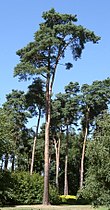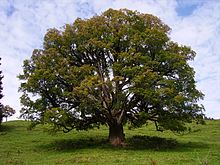Loading AI tools
Clade of seed plants From Wikipedia, the free encyclopedia
A seed plant or spermatophyte (lit. 'seed plant'; from Ancient Greek σπέρματος (spérmatos) 'seed' and φυτόν (phytón) 'plant'), also known as a phanerogam (taxon Phanerogamae) or a phaenogam (taxon Phaenogamae), is any plant that produces seeds. It is a category of embryophyte (i.e. land plant) that includes most of the familiar land plants, including the flowering plants and the gymnosperms, but not ferns, mosses, or algae.
| Seed plants Temporal range: | |
|---|---|
 | |
| Scots pine, Pinus sylvestris, a member of the Pinophyta | |
 | |
| Sycamore maple, Acer pseudoplatanus, a member of the Eudicots | |
| Scientific classification | |
| Kingdom: | Plantae |
| Clade: | Tracheophytes |
| Clade: | Spermatophytes |
| Extant divisions | |
| Synonyms | |
| |
The term phanerogam or phanerogamae is derived from the Greek φανερός (phanerós), meaning "visible", in contrast to the term "cryptogam" or "cryptogamae" (from Ancient Greek κρυπτός (kruptós) 'hidden'), together with the suffix γαμέω (gaméō), meaning "to marry". These terms distinguish those plants with hidden sexual organs (cryptogamae) from those with visible ones (phanerogamae).
The extant spermatophytes form five divisions, the first four of which are classified as gymnosperms, plants that have unenclosed, "naked seeds":[1]: 172
The fifth extant division is the flowering plants, also known as angiosperms or magnoliophytes, the largest and most diverse group of spermatophytes:
In addition to the five living taxa listed above, the fossil record contains evidence of many extinct taxa of seed plants, among those:
By the Triassic period, seed ferns had declined in ecological importance, and representatives of modern gymnosperm groups were abundant and dominant through the end of the Cretaceous, when the angiosperms radiated.

A whole genome duplication event in the ancestor of seed plants occurred about 319 million years ago.[2] This gave rise to a series of evolutionary changes that resulted in the origin of modern seed plants.
A middle Devonian (385-million-year-old) precursor to seed plants from Belgium has been identified predating the earliest seed plants by about 20 million years. Runcaria, small and radially symmetrical, is an integumented megasporangium surrounded by a cupule. The megasporangium bears an unopened distal extension protruding above the mutlilobed integument. It is suspected that the extension was involved in anemophilous (wind) pollination. Runcaria sheds new light on the sequence of character acquisition leading to the seed. Runcaria has all of the qualities of seed plants except for a solid seed coat and a system to guide the pollen to the seed.[3]
Runcaria was followed shortly after by plants with a more condensed cupule, such as Spermasporites and Moresnetia. Seed-bearing plants had diversified substantially by the Famennian, the last stage of the Devonian. Examples include Elkinsia, Xenotheca, Archaeosperma, "Hydrasperma", Aglosperma, and Warsteinia. Some of these Devonian seeds are now classified within the order Lyginopteridales.[4]
Seed-bearing plants are a clade within the vascular plants (tracheophytes).[5]
The spermatophytes were traditionally divided into angiosperms, or flowering plants, and gymnosperms, which includes the gnetophytes, cycads,[5] ginkgo, and conifers. Older morphological studies believed in a close relationship between the gnetophytes and the angiosperms,[6] in particular based on vessel elements. However, molecular studies (and some more recent morphological[7][8] and fossil[9] papers) have generally shown a clade of gymnosperms, with the gnetophytes in or near the conifers. For example, one common proposed set of relationships is known as the gne-pine hypothesis and looks like:[10][11][12]
| Spermatophytes |
| |||||||||||||||||||||||||||
However, the relationships between these groups should not be considered settled.[6][13]
Other classifications group all the seed plants in a single division, with classes for the five groups:[citation needed]
A more modern classification ranks these groups as separate divisions (sometimes under the Superdivision Spermatophyta):[citation needed]
Unassigned extinct spermatophyte orders, some of which qualify as "seed ferns":[citation needed]
Seamless Wikipedia browsing. On steroids.
Every time you click a link to Wikipedia, Wiktionary or Wikiquote in your browser's search results, it will show the modern Wikiwand interface.
Wikiwand extension is a five stars, simple, with minimum permission required to keep your browsing private, safe and transparent.